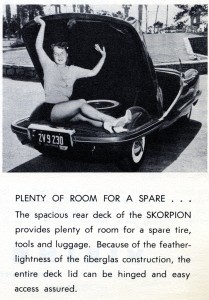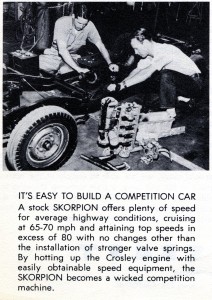
Hi Gang…
The Skorpion was designed by Ralph Roberts of LeBaron Coachworks fame, and built by John Wills of fiberglass and plastic fame. Two innovators and creators at the top of their game who brought us one of the first fiberglass sports cars starting in 1951. These men owned the company for 1-2 years and sold it with the rights to build the Skorpion body to Doug Carruthers of Viking-Craft.
Let’s see what Viking-Craft had to say about the Skorpion in 1953.
Skorpion: America’s Newest Sports Car
It’s fun to drive a Skorpion – it’s a big new thrill. The extremely light weight, low center of gravity and efficient streamlining give it outstanding characteristics – for approximately half the cost of the most popular imported sports cars
It’s fun to build a Skorpion too. Planning, bringing together the components and building it, is absorbing to anyone interested in good motor cars. From the start you can ride it, test it, and tune it; all through the process of assembly.
Bases of the Skorpion is a fiberglass body, light, tough, quiet, rustproof and dent proof – the ideal material for a rugged sports car. The body is sold as a kit, comprised of a complete set of body sections, and other body items which are special on this job. There is no framing in the body, the skin is the whole thing.
Body panels are assembled by the customer on a chassis which he builds or buys. Wheelbase is 80”, track 42”, wheels and tires are 4.50 x 12. Curb weight of complete car is approximately 1050 lbs. Although a chassis using any small engine up to the size of the Ford V8 “60” may be custom built by the customer, the simplest installation is the Crosley.
The stock chassis fits the Skorpion body completely without alteration except for lowering. It has also been found that the Crosley engine in this light car, provides remarkable performance for ordinary use. When modified for road racing, it makes a hot competition job.
Complete assembly drawings and directions for making the Crosley chassis conversion are supplied with each body kit. It is not a difficult job. All Crosley working parts: power plant, final drive, axles, suspension, steering, etc. are left entirely unchanged, a decided advantage from the service standpoint. Briefly, the usual procedure is as follows:
First, the chassis is procured. This may be brought new, but as an economy measure it is usually provided by purchasing a used Crosley car, any body style, of 1947 or later year. The body is lifted off, chassis reconditioned and test-driven.
Chassis is now ready for “conversion” for the Skorpion body. This involves lowering the mid-section of the frame, radiator, steering column and other controls, and mounting a light outrigger frame for attachment of the body. We are now ready for mounting of the body itself, which is solidly attached by only eight bolts.
Balance of the project involves finishing operations such as filling in the floor, firewall and instrument panel, installing windshield, lamps, hardware, accessories, wiring and painting. Kits are supplied in lacquer prime, ready for color coats.
The conversion outlined above is an easy job for anyone mechanically inclined. It goes along quickly even when done by one person, and is soon completed when jointly undertaken by a pair or group of enthusiasts. The construction of special chassis to accommodate other engines takes longer and requires more basic mechanical experience.
To assist in determining possible chassis layouts for these special cases, we are able to supply at the normal price of 50 cents per copy, a scale drawing showing the silhouette of the Skorpion body, on which the customer may lay out the frame, engine and final drive which he may wish to build.
Summary:
The Skorpion molds were sold by Carruthers and at least two other companies produced bodies using these molds thru the late part of the ‘50s. But of course the most intriguing Skorpion of all, was just on the horizon – the V8-60 Ford Flathead powered “Super Skorpion.” More about that interesting and powerful sports car in a future story here at Forgotten Fiberglass.
Hope you enjoyed the story, and until next time…
Glass on gang…
Geoff
——————————————————————-
Click on the Images Below to View Larger Pictures
——————————————————————-









This site is protected by reCAPTCHA and the Google Privacy Policy and Terms of Service apply.